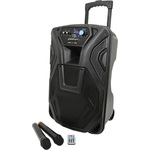Wireless Audio
Introduction
Wireless is a term used for any pieces of equipment that connect to each other without using wires or cables. The main usage for this is to transmit information between appliances and most often, this is achieved using radio waves. In sound equipment, this usually means transmitting the audio signal.
Radio waves are a type of electro-magnetic wave that exist in nature and can be produced by electronic equipment. There are other types of electro-magnetic waves, such as X-rays, microwaves, infra-red and even visible light, so you can imagine that radio waves are a type of light that is invisible and can travel through walls.

One of the most prominent early uses of radio waves to transmit audio was from radio stations, which use large, amplified transmitter aerials to broadcast music and information programmes nationwide and even worldwide. These could be tuned into by domestic 'radiograms' in the listener’s home. The original method used was called Amplitude Modulation, or AM radio
Amplitude modulation generates a radio wave at a specific frequency and varies the amplitude (or intensity) of it in relation to the audio it is carrying. If this was visible light, it would be at a specific colour (frequency) and the brightness (amplitude) of it would be varying in relation to the audio wave it is carrying. The following example is not to scale and uses the example of a sine wave for the audio signal to help describe the effect. In reality, the audio would be far more complex than this.

It is worth remembering that radio waves are much higher frequency than any audible sound, so the carrier frequency does not affect the audio signal itself.
AM radio could be divided into different “wavelengths” measured in metres (m) and frequency is measured in kilohertz (kHz), which is 1000 cycles per second. or Megahertz (MHz) which is 1000,000 cycles per second.
* Long Wave............1000m – 2000m........153kHz – 279kHz
* Medium Wave.......200m – 1000m..........531kHz – 1602kHz
* Short Wave...........10m – 80m............... 3.5MHz – 29.7MHz
The wavelength is the distance between 2 peaks in the radio wave. Radio waves all travel at the same speed, i.e. the speed of light, so longer wavelengths have lower frequencies and short wavelengths have higher frequencies.
FM Radio
Later developments in radio technology brought higher quality audio and even stereo (separate left + right output) by transmitting at even higher radio frequencies, called Very High Frequency (VHF). This band operates across 30MHz - 300MHz and instead of varying the Amplitude of the radio wave, the new technology used small variances in the radio carrier frequency itself, called Frequency Modulation (FM). Again, the diagram is not to scale and shows the audio signal as a simple sine wave for illustration purposes.

Wireless Microphones
This same band of VHF frequencies is used for FM radio, terrestrial TV broadcast, walkie-talkies etc. Specifically for performers, this band is also used for wireless microphone systems. A narrow band is permitted for use without license (173.8MHz - 175.0MHz in the UK), allowing up to 3 wireless microphones (with carefully selected carrier frequencies) to operate in the same vicinity without interference. These must also be classed as Short-Range Devices (SRD) by having no more transmission power than 25mW, depending upon the transmitter type.
Licensing
The radio spectrum in the UK is governed by the Office of Communications (OFCOM) and it is worth remembering that licensing the radio spectrum to various broadcasters, communications providers and private users is an important source of revenue for the government. Also, military and emergency services have certain bands of frequencies set aside for their use only, so it is important to stick to the legally permitted radio frequencies to avoid any risk of prosecution.

Wireless Range
Since radio waves naturally travel outwards in all directions from the source, the signal becomes more thinly spread the further away from the source it is (this is similar for light and for sound waves). If a radio transmitter has unlimited power, it will be able to transmit over an unlimited distance. However, his would not be ideal for wireless microphones, since there is a limited carrier band that all wireless microphones need to share and if the transmission from a single transmitter was too strong, it would occupy a very wide area and interfere with other wireless microphones operating on the same frequencies within this range.
Wireless microphones and other performer devices need to use batteries for power, to avoid them being tethered by a power lead, which means that there will be limited transmission power anyway. Wireless microphones are categorised as Short Range Devices (SRD) and may be legally used only if they meet certain requirements. Aside from being restricted to the permitted carrier frequency bands, they cannot deliver more than 25mW of transmission power from a bodypack or 10mW from a handheld transmitter, which usually provides up to 60m maximum range in open air (obstacles will reduce this further)
Beyond the VHF Band
Since VHF has limitations in how many systems can operate together in a particular area (normally up to 3 sets at once in the license-free band), the only solution to use more systems together is to use different frequencies. As technology progressed, higher carrier frequencies became accessible called Ultra High Frequency (UHF), in which there is another license-free band of 863MHz - 865MHz. Here, up to 4 more carrier frequencies can operate together without interference (using the right equipment, such as the Chord NU4 system)
The ever-increasing demand for additional systems to be operated together meant that additional bands of VHF frequencies were set aside for performers, but these need to be used under paid-for Program-Making and Special Events (PMSE) licenses. In the UK, Channel 38 is such a band, running from 606MHz - 614MHz, with licenses issued by OFCOM upon request.
Analog vs Digital
Up to this point, the transmitted signal has been shown as a sine wave, which is the simplest sound wave or audio wave. This is an analog (or analogue) signal, which describes the continually changing audio voltage that is converted into air pressure vibrations to produce sound.
The advent of the digital age has brought with it the technology of Digital Audio. When an audio signal is described as being "Digital", it means that its waveform has been sampled at very fast, regular intervals and measured to produce a number for each sample, which is then converted to binary data (i.e. ones and zeros). When the audio is needed to make sound, this stream of numbers is converted back into voltages, which are then used to create sound in the traditional manner.
Digital audio is now widely used as an efficient way to process, send and store audio data, delivering clean, high-quality audio. This technology can also be applied to wireless audio transmission, which maintains the audio in digital numerical format over the radio waves, eliminating most of the unwanted noise induced by the transmitting and receiving circuitry. The diagram below is purely to illustrate this effect. In reality, frequencies would be much higher and the FM shift would be far more subtle.

Wireless Networking
Whilst digital audio can be streamed over the standard wireless microphone frequencies without issue, there is still limited bandwidth if multiple transmitters are needed. There are other license-free radio frequencies that are already used for transmitting digital signals that are standardised worldwide. These frequencies carry the wireless internet, or WiFi, that we use to connect laptops and smart devices together for communication with a local network and further connected to the internet.
The most common set of WiFi frequencies is known as the 2.4GHz (or 2.4G) band and this ranges from 2.400GHz to 2.484GHz (1 GigaHertz = 1 billion cycles per second). As shown in the diagrams above, the carrier frequency is always much faster than the signal that it is carrying, and this is a very important relationship. A faster carrier can carry a faster signal, and a faster signal contains more data per second than a slower signal. Since 2.4GHz is very fast, this means it can carry a lot of data in a very short time.
Packet Data
Many devices will share the same WiFi frequency to send and receive data to and from any number of other devices. How this is achieved without all the digital signals being mixed up together is through a process of time-sharing, which compresses each piece of data to a very small burst of data called a “packet”. Each packet will have a signature at the beginning of its data to indicate what it is and what is its intended target. This allows only the relevant data to reach the correct target and for others to be ignored until another relevant packet of data is transmitted in the same stream.
In the illustration below, 3 devices are taking turns to transmit packets of data, which results in a continuous stream of all 3 data sources, which is then received by 3 target devices. Device 1 in red is paired with the receiving device (also numbered 1) and this receiving device only “listens” to the red packets in the data stream, ignoring or discarding green and blue packet data. Similarly, device 2 only takes in green data and device 3 only takes in blue data, disregarding others.
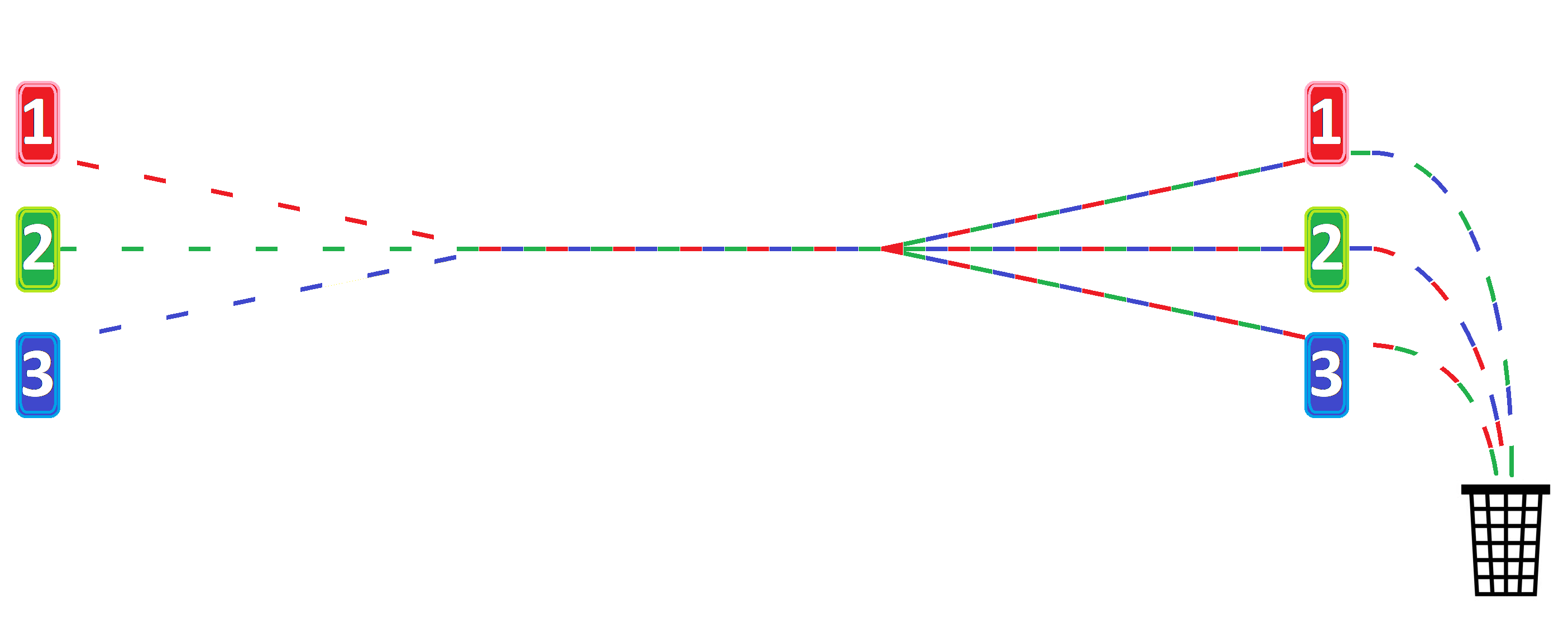
In reality, many more devices will be transmitting and receiving packets of data very quickly all at the same time on the same frequency, allowing them all to share the data stream on a single radio carrier frequency.
Bluetooth®
One particular technology that takes advantage of this technique for audio streaming is Bluetooth, which operates within the same 2.4G band as WiFi. Bluetooth is a system where wireless digital devices connect with each other exclusively and ignore all data not intended for each device. Each Bluetooth device continually transmits its identity when it is in pairing mode, allowing all other Bluetooth devices to detect it if they are within Bluetooth wireless range. Any detected device can then be selected for “pairing”, which means that the devices agree to recognise each other. They can then be set to “connect” wirelessly, which means that they can then transfer data wirelessly only between themselves. Normally this is just for 2 devices, but more recent Bluetooth versions can allow for simultaneous reception on 2 devices from 1 transmitter.
Latency
The process of compressing digital audio data into smaller packets for sending then decompressing and decoding at the receiving end will incur some delay between the transmitted audio and receiver. This delay is known as “latency” and in Bluetooth, this would be quite noticeable, since there is an audible fraction of a second where the audio is being encoded, compressed and transmitted in packets with the address data of its intended paired target, received and decoded at the other end. For recorded material and hands-free calling, this is not really a problem, since the original audio is not heard along with the audio from the Bluetooth receiver.
2.4G for Live Performers
For digital wireless microphones, musical instrument wireless and in-ear monitoring systems, an audible delay would be obtrusive since the sound is being produced and monitored in real time. This could be a singer listening back to their own voice or a guitar player hearing the notes that they play through a guitar amplifier. These performers need accuracy of timing and immediate foldback. For these systems, new technologies have emerged to prioritise audio data streams and “channel-hop” across different frequencies within the WiFi band to ensure the clearest carrier frequency is used and to continuously and quickly send data with minimal latency. This latency is usually no more than 5ms (milliseconds) and although such short time differences may be perceptible to the human ear, a delay of up to 10ms is perfectly manageable for live sound performances.
Even Higher Frequencies
To cope with the heavy demand on the 2.4G band, further bands were opened for WiFi data with even higher carrier frequencies. The next such band after 2.4G is the 5.8G band, operating between 5.725GHz and 5.850GHz. Newer versions of audio wireless systems are now using the 5.8G band to avoid the crowded 2.4G radio band and work in much the same way as for 2.4G
Further, even higher license-free frequencies are opening for WiFi and these may also be exploited for wireless audio in the future. For now, 2.4G and 5.8G are working well in many existing systems.

Contents
Related Items
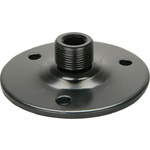
Gooseneck Bases
Black
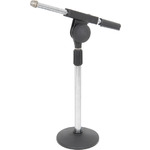
Desk Stand with Boom
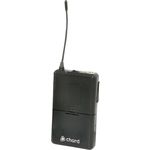
Beltpack Transmitters for NU1 Systems
863.1MHz
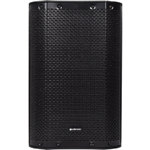
CASA Active PA Cabinets with DSP, USB/SD and Bluetooth
8" 200W RMS
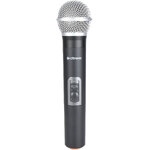

FLITE-series Replacement Transmitters
Handheld - 864.5MHz
